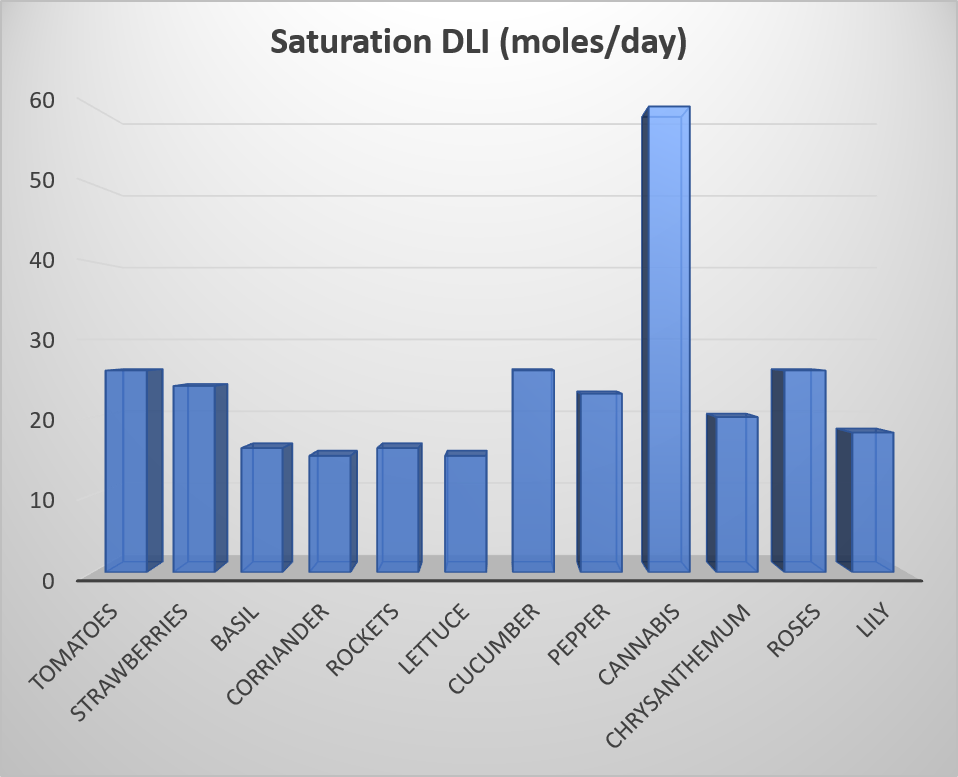the Science of Light
the basic science of light
The sun, a great ball of burning gas in space, provides us with sunlight but also a lot more than that
The electromagnetic energy waves emitted by the sun range from cosmic rays all the way through to radio waves
The range of electromagnetic waves that we can see as light forms a very small part of what passes through the Earth’s atmosphere
The range from upper UV to low infrared is considered visible light and is typically broken into three groups: blue, green and red
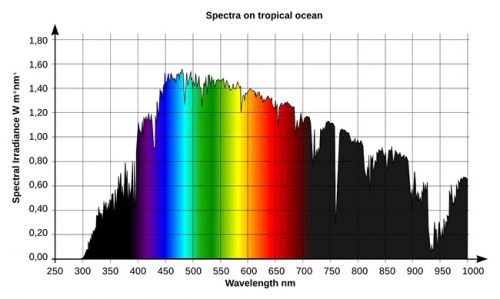
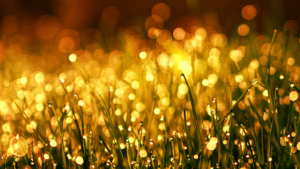
The combination of red green blue (RGB) create what we consider as white light
The human eye has a greater photopic sensitivity to the middle band of wavelengths from about 530nm to 630nm with the photopic peak being 555 nm
By contrast, photosynthesis in plants is stimulated by a broad range of light wavelengths from upper UV through to low Infra Red.
A lot of times the PAR range is mis-quoted as being from 400 to 700nm but in reality, nature gives us things for a reason and plants, evolving over billions of years, use a broader range of light wavelengths than this precise definition
the importance of broad spectrum lighting
A lot of people will criticise my chart below and say that it is incorrect. But read on…..
Dr Keith McCree is considered a leading expert in the science of light. In the 1970s he undertook a series of tests and experiments to determine the action spectrum, absorptance and quantum yield of photosynthesis in crop plants.
An extract from his paper states “the spectrum, absorptance and spectral quantum yield of CO2 uptake were measured, for leaves of 22 species of crop plant, over the wavelength range 350 to 750 nm”
His famous McCree curve shows this but mistakenly, books, papers and many references, and sadly some quantum meters and PAR sensors, quote or measure the PAR range as limited from 400nm to 700nm
In fact, I am sure that plants respond to other electromagnetic energy waves that we have yet to effectively test on plant growth responses.
McCree completed an incredible piece of work using rudimentary technology and, if alive today and with modern LEDs, he would, I am sure, create a fuller and more complete PAR curve.
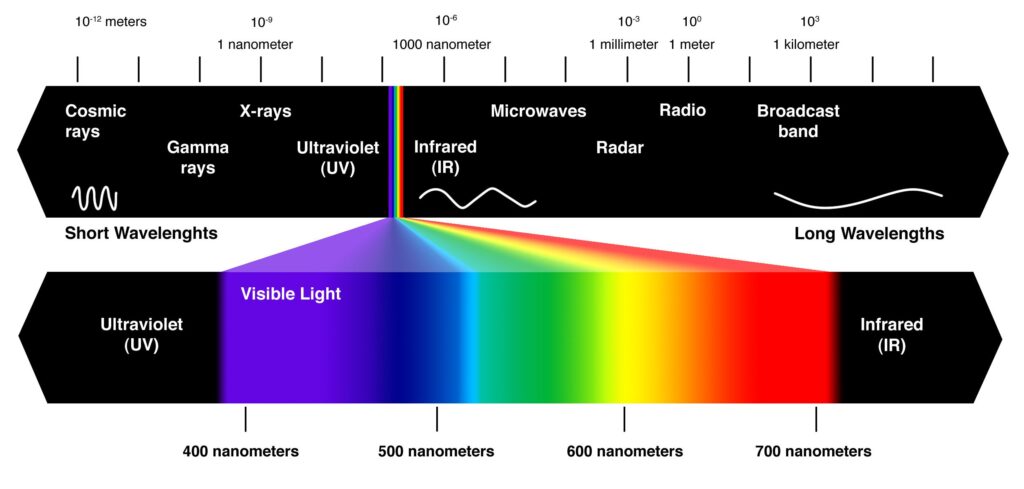
We already know from many experiments conducted by scientific experts such as Prof Bruce Bugbee that Far red has a profound effect on plant growth
In fact, the McCree curve is likely to be incomplete and the dotted lines on the chart indicate a more likely photosynthetic reaction curve
The photosynthetic process is described elsewhere in this website but what about the quality of light or spectrum of light?
How does this affect photosynthesis and plant growth?
We can see from the photosynthetic equation that low energy molecules of carbon dioxide (CO2) and water (H2O) combine and separate during photosynthesis to create high energy Carbohydrates (sugars) and oxygen
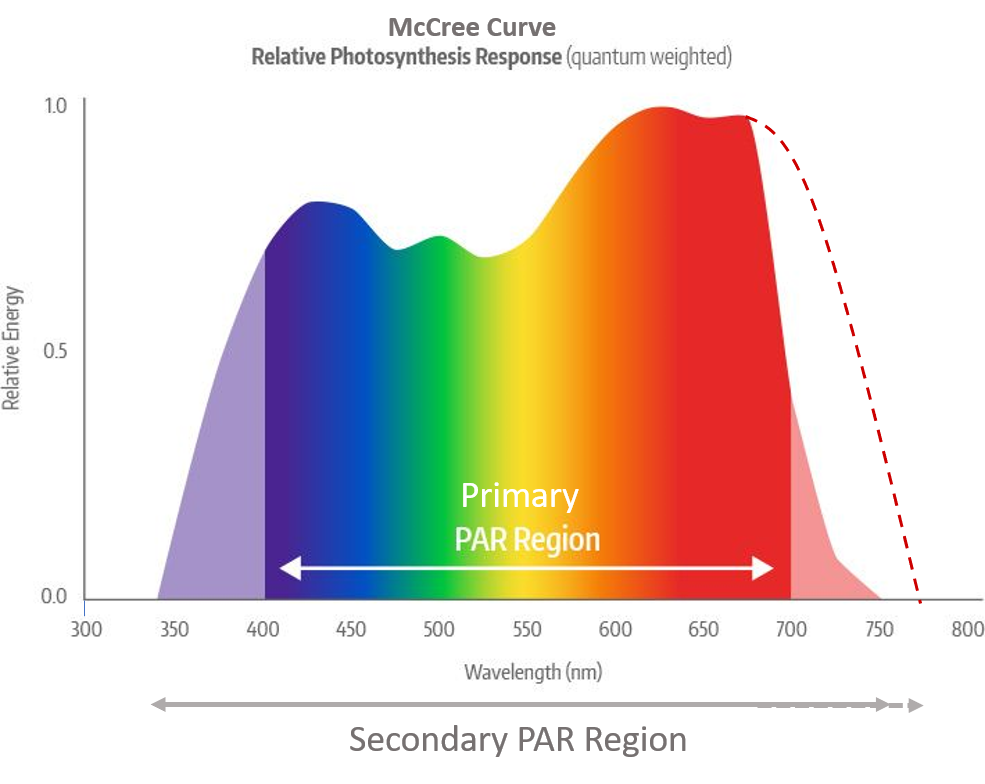
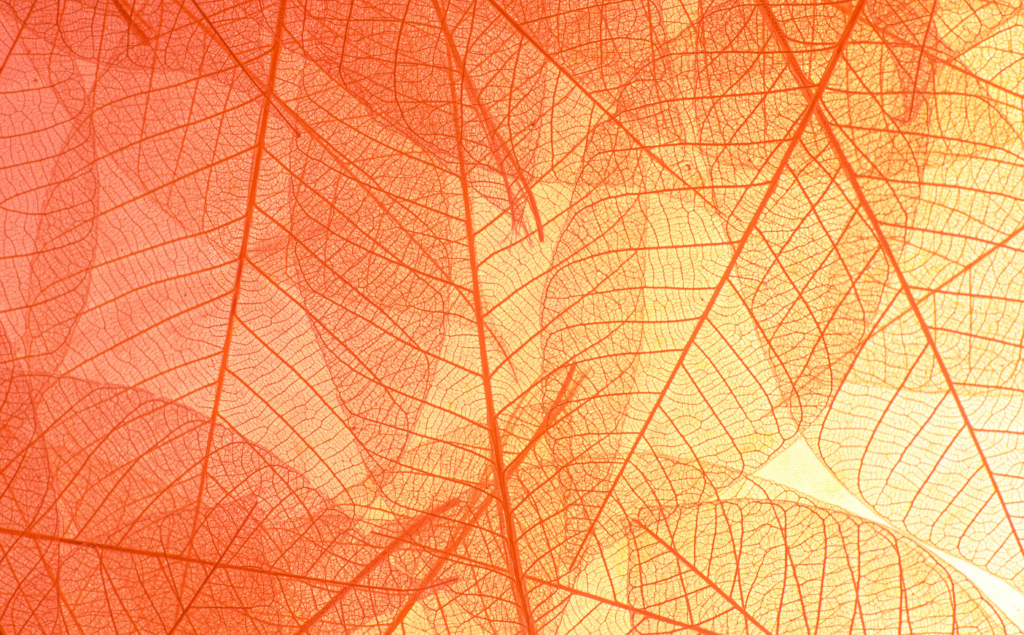
It takes a minimum of 10 photons of light energy to raise the low energy molecules of CO2 and H2O and create the high energy carbohydrates and oxygen.
Therefore it is light energy (number of photons) that enables photosynthesis and affects the growth rate of a plant and yield
Light spectrum, or more specifically, the ratio of light spectrum affects the development (morphology) and shape of a plant
The reason for this is that light provides electromagnetic energy and spectrum provides signals to the plant that make it respond in different ways
A plant receives information from the light through special pigments, called photoreceptors.
These photoreceptors are sensitive to different wavelengths of the light spectrum
There are three groups of photoreceptors:
- Phototropins
- Cryptochromes
- Phytochromes
The first two – phototropins and cryptochromes – are active in the upper UVA, violet and blue range of wavelengths (380 to 480 nm) (UV (A) and blue). These two receptors obviously have different functions
Phototropins are responsible for phototropism (i.e. the orientation and movement of the plant towards light). They are what cause stems to bend towards light and stomata to open.
Cryptochromes sense the direction of the light and inhibit stem elongation.
Phytochromes – are sensitive to red and far red light and have two forms, Pfr and Pr, which interact.
The ratio of Pfr and Pr influence stem elongation, shade avoidance, chlorophyll synthesis and the flowering response.
Plant developmental responses to different spectra of light can be summarised as follows:

green, far red and UV light
Let us explore each part of the spectrum to see how these influence plant development
Upper Ultra Violet (UV) helps to treat disease and trigger cannabinoid synthesis in marijuana and flavonoid production in other species
Blue inhibits cell expansion such that a light with more blue results in shorter plants but it promotes good root growth.
Lights with high amounts of blue are good for germination, propagation and vegetative growth.
Chlorophyll absorbs blue maximally at 430nm
Red is a significant photosynthetic colour and triggers cell expansion, flowering and rapid growth.
Chlorophyll absorbs red maximally at 662nm
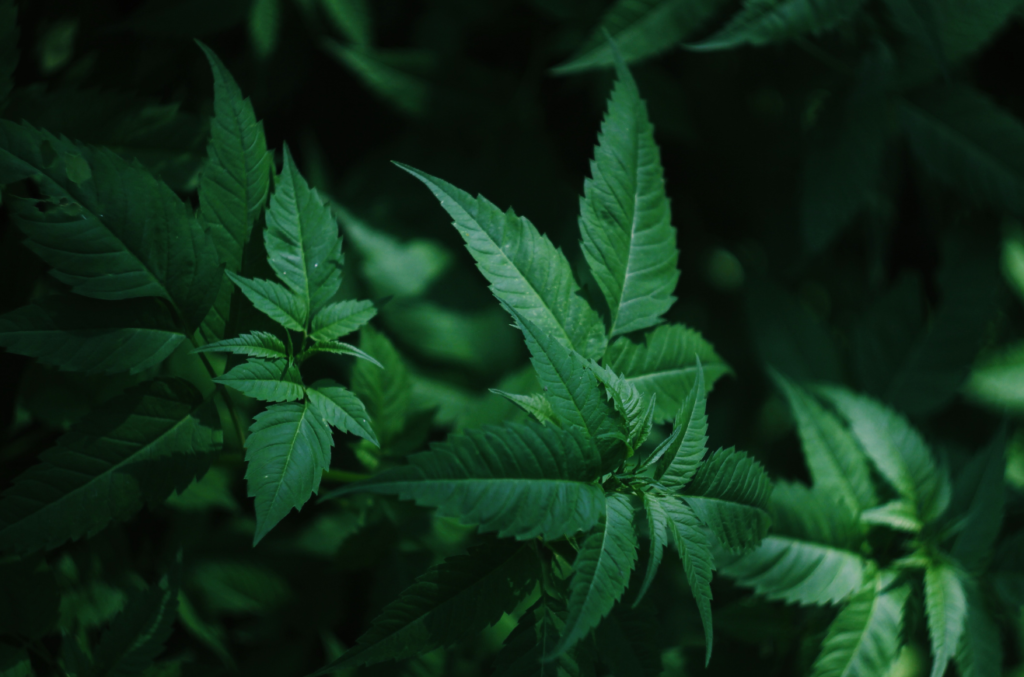
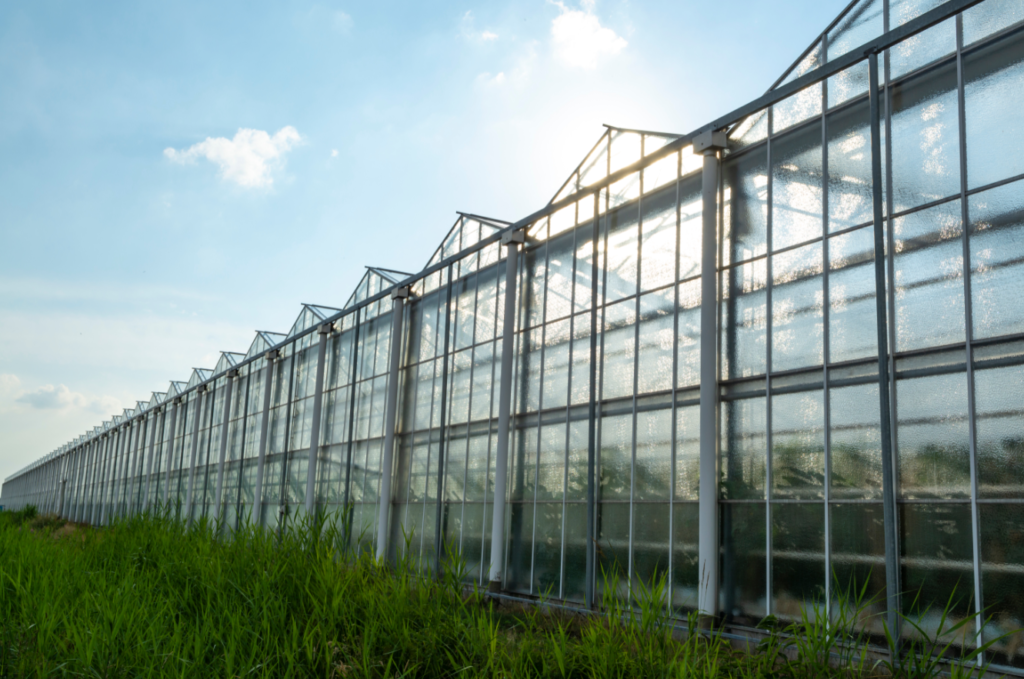
Green – facilitates human vision plus is a significant contributor to photosynthesis. This is discussed in more detail in this website
Far red at 730nm to 750nm triggers a change in the ratio of Pfr and Pr thereby influencing stem elongation, shade avoidance, chlorophyll synthesis and the flowering response.
Too much Far red can be undesirable in certain shade avoidance species such as tomatoes and cucumber but small amounts can induce earlier flowering.
Leafy greens are shade tolerance and therefore larger amount of far red is good since it creates broader and bigger leaves and fresh weight
UV and Far Red should be included when assessing the capability and full PPF potential of grow lighting
green light
By utilizing just narrow band red/blue LEDs in sole-source lighting conditions these pigments are not able to optimize their light harvesting capabilities.
The majority of red and blue light is absorbed by chlorophyls with a portion of green light reflected.
Once Chlorophylls have fully absorbed red and blue light, any additional light is rejected as heat and does not increase photosynthetic efficiency
As discussed elsewhere in this website, chlorophylls are not the only photoreceptors that promote photosynthesis
Carotenoids are red, orange and yellow-coloured pigments and absorb bluish-green light between 460nm and 550nm
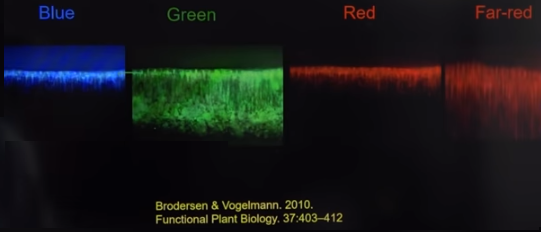
Research by Brodersen and Vogelmann in 2010 shows that green light, and infra red, penetrates through the leaf structure
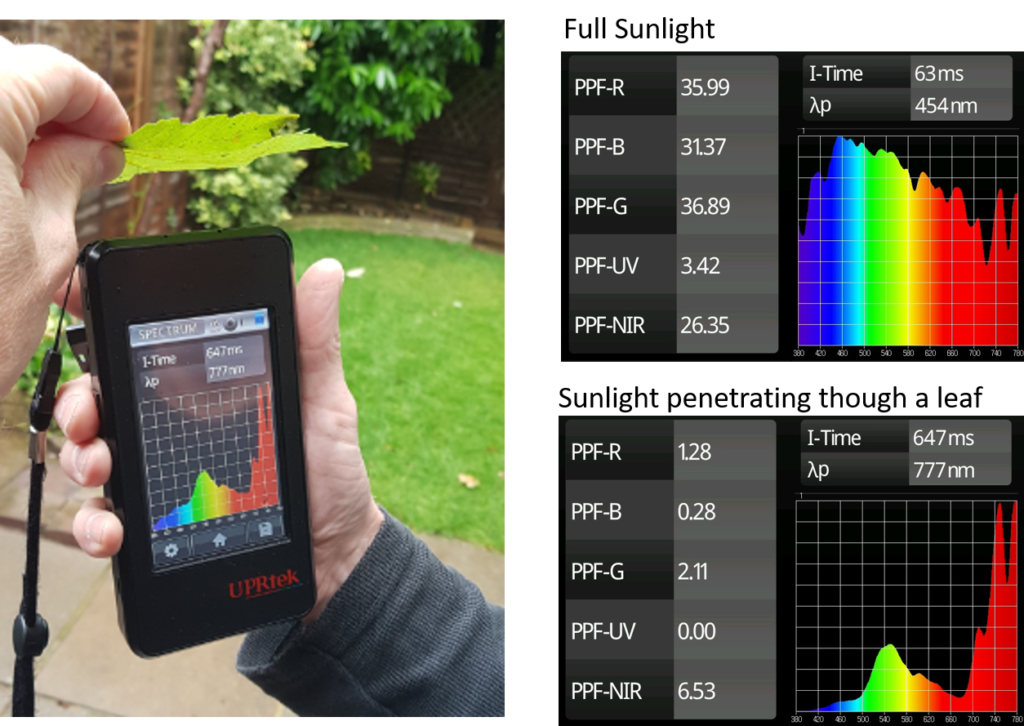
A large percentage (about 40%) of green light penetrates further into the leaf than red or blue light
Penetrating green light increases photosynthesis by exciting chloroplasts containing caroteniods located deep in the mesophyll (Ichiro Terashima, Takashi Fujita, Takeshi Inoue, Wah Soon Chow, Riichi Oguchiet 2009)
Broad spectrum LED lights that include green will therefore allow a greater increase in photosynthetic efficiency than a LED solution with just red and blue wavelengths (Björkmann 1968 , Balegh and Biddulph 1970)
Green light continues to penetrate through leaf surfaces and therefore reaches the lower canopy
This is very important in dense canopy production techniques which are common in controlled environment agriculture. Green leaves of land plants absorb a substantial fraction of green light ( McCree 1972, Inada 1976, Gates 1980 ).
Impact of PPFD & DLI on Plant Growth
PPFD = Photosynthetic Photon Flux Density measured in µmol / m² / s
It is the measure of how much useful PAR light energy is reaching the plant
This directly drives the amount of growth the plant achieves per hour and per day
Over the course of a day the total useful PAR light received is known as the Daily Light Integral (DLI) measured in mol / day
The calculation of DLI = PPFD x 3600 / 10 power 6 (ie a million) = mol per m2 x hours usage
Certain high yield crops require a significantly higher DLI than fruit, vegetable, herb or flowering plants
F.A.Q.
if you cannot find the answer to your question then please send via contact page
This depends on the crop that you are growing and the environment that you are growing in. For example, tomato crops grown in a greenhouse can be very efficiently and effectively lit with a 95% red and 5% blue light. Conversely, a basil plant grown in a vertical farm benefits most from a broad spectrum light of approximately 4000 K.
In glasshouses, we would recommend using red/blue/far red in proportions of approximately 95%/4%/1% for tomatoes, peppers, cucumbers and strawberrie. For fully internal growing (i.e. no sunlight), we would recommend a broad spectrum light (3000K to 4000K), high CRI with additional 4% of far red for bushy crops, basil, and salad crops.
Plants appear green to the human eye because they reflect a portion of the green spectrum. It was long believed that as a result, green was not used in photosynthesis. However, studies conducted over the past few years have shown that green plays a very big part in the photosynthetic process (see explanation above). In a glasshouse, natural sunlight provides this part of the spectrum which is why a red/blue light is sufficient. In a fully indoors environment, broad spectrum lights with a large portion of green result in a very good quality plant with improved plant development.
Infra red light in the range 700nm to 730nm increase plantcell growth resulting in a taller plant but also triggers a flowering signal in the plant resulting in very strong flower development and increased yield.
UV light can be used to help reduce the potential build up of mildews and other pathogenic growths and can also increase flavinoid production. However, if used too much it can stress the plant. It is best to buy a separate UV module and only use it for about an hour a day in the final two weeks before harvest or if you have a mildew issue.

